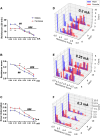Different mechanisms underlie compulsive alcohol self-administration in male and female rats
- PMID: 38368341
- PMCID: PMC10874042
- DOI: 10.1186/s13293-024-00592-5
Different mechanisms underlie compulsive alcohol self-administration in male and female rats
Abstract
Background: Sex is an important factor in the progression and treatment of alcohol addiction, and therapeutic approaches may have to be tailored to potential sex differences. This highlights the importance of understanding sex differences in behaviors that reflect key elements of clinical alcohol addiction, such as continued use despite negative consequences ("compulsive use"). Studies in experimental animals can help provide an understanding of the role sex plays to influence these behaviors.
Methods: Large populations of genetically heterogeneous male and female Wistar rats were tested in an established model of compulsive alcohol self-administration, operationalized as alcohol responding despite contingent foot shock punishment. We also tested baseline (fixed ratio, unpunished) operant alcohol self-administration, motivation to self-administer alcohol (progressive ratio), and temporal discounting for alcohol reward. In search of predictors of compulsivity, animals were screened for novelty-induced place preference, anxiety-like behavior, pain sensitivity and corticosterone levels. The estrous cycle was monitored throughout the study.
Results: Unpunished self-administration of alcohol did not differ between males and females when alcohol intake was corrected for body weight. Overall, females showed higher levels of compulsive responding for alcohol. Compulsive response rates showed bimodal distributions in male but not in female rats when intermediate shock intensities were used (0.2 and 0.25 mA); at higher shock intensities, responding was uniformly suppressed in both males and females. We also found less steep discounting in females when alcohol was devalued by delaying its delivery. Males exhibited a stronger motivation to obtain alcohol under unpunished conditions, while females showed higher corticosterone levels at baseline. Factor analysis showed that an underlying dimension related to stress and pain predicted compulsivity in females, while compulsivity in males was predicted by a reward factor. We did not find differences in alcohol-related behaviors throughout the various stages of the estrous cycle.
Conclusions: Our results suggest that mechanisms promoting compulsivity, a key feature of alcohol addiction, likely differ between males and females. This underscores the importance of considering sex as a biological variable in both preclinical and clinical research, and has potential treatment implications in alcohol addiction.
Keywords: Alcohol; Compulsivity; Motivation; Operant self-administration; Sex differences; Stress.
Plain language summary
Sex plays an important role in the progression and treatment of alcohol addiction. While men show a higher prevalence of alcohol addiction, women are more susceptible to the adverse effects of excessive alcohol consumption. Additionally, women often rely on heavy drinking as a maladaptive coping mechanism to alleviate stress and anxiety, driven by negative affect. On the other hand, men are more likely to report heavy drinking and relapse in response to positive emotions and social influences. These sex-based differences underline the importance of understanding how vulnerability to alcohol addiction and its treatment varies in males and females.We used genetically heterogeneous rats to explore the behavioral traits that contribute to compulsivity, a key clinical feature of alcohol addiction. We found that motivation to self-administer alcohol was higher in males, while females showed higher compulsive alcohol self-administration. In males, motivation to self-administer alcohol showed a significant correlation with compulsivity, while in females compulsivity was predicted by higher basal corticosterone levels.These findings underlie the importance of sex-specific factors in compulsive alcohol self-administration, with potential prevention and treatment implications in alcohol addiction.
© 2024. The Author(s).
Conflict of interest statement
M.H. has received consulting fees, research support, or other compensation from Indivior, Camurus, BrainsWay, Aelis Farma, and Janssen Pharmaceuticals. The other authors declare that they have no competing interests.
Figures






Similar articles
-
Sex- and age-specific effects on the development of addiction and compulsive-like drinking in rats.Biol Sex Differ. 2023 Jul 7;14(1):44. doi: 10.1186/s13293-023-00529-4. Biol Sex Differ. 2023. PMID: 37420305 Free PMC article.
-
Increased Responding for Alcohol and Resistance to Aversion in Female Mice.Alcohol Clin Exp Res. 2020 Jul;44(7):1400-1409. doi: 10.1111/acer.14384. Epub 2020 Jun 18. Alcohol Clin Exp Res. 2020. PMID: 32472651
-
Compulsive sucrose- and cocaine-seeking behaviors in male and female Wistar rats.Psychopharmacology (Berl). 2018 Aug;235(8):2395-2405. doi: 10.1007/s00213-018-4937-1. Epub 2018 Jun 15. Psychopharmacology (Berl). 2018. PMID: 29947917 Free PMC article.
-
Genetically selected alcohol-preferring msP rats to study alcohol use disorder: Anything lost in translation?Neuropharmacology. 2021 Mar 15;186:108446. doi: 10.1016/j.neuropharm.2020.108446. Epub 2021 Jan 18. Neuropharmacology. 2021. PMID: 33476639 Free PMC article. Review.
-
Compulsivity in obsessive-compulsive disorder and addictions.Eur Neuropsychopharmacol. 2016 May;26(5):856-68. doi: 10.1016/j.euroneuro.2015.12.003. Epub 2015 Dec 11. Eur Neuropsychopharmacol. 2016. PMID: 26774279 Review.
Cited by
-
Punishment-resistant alcohol intake is mediated by the nucleus accumbens shell in female rats.Neuropsychopharmacology. 2024 Dec;49(13):2022-2031. doi: 10.1038/s41386-024-01940-0. Epub 2024 Jul 29. Neuropsychopharmacology. 2024. PMID: 39080457 Free PMC article.
-
Individual and sex differences in frontloading behavior and approach- avoidance conflict preference predict addiction-like ethanol seeking in rats.Sci Rep. 2025 Jan 23;15(1):2982. doi: 10.1038/s41598-024-82517-1. Sci Rep. 2025. PMID: 39848982 Free PMC article.
-
Distinct sex differences in ethanol consumption and operant self-administration in C57BL/6J mice with uniform regulation by glutamate AMPAR activity.Front Behav Neurosci. 2025 Jan 22;18:1498201. doi: 10.3389/fnbeh.2024.1498201. eCollection 2024. Front Behav Neurosci. 2025. PMID: 39911242 Free PMC article.
-
Individual differences in punished alcohol self-administration are unaltered by alcohol vapor exposure.Alcohol. 2025 Jun;125:43-52. doi: 10.1016/j.alcohol.2025.03.003. Epub 2025 Mar 17. Alcohol. 2025. PMID: 40107522
-
Role of serotonin neurons in the dorsal raphe nucleus in heroin self-administration and punishment.Neuropsychopharmacology. 2025 Feb;50(3):596-604. doi: 10.1038/s41386-024-01993-1. Epub 2024 Sep 19. Neuropsychopharmacology. 2025. PMID: 39300273 Free PMC article.
References
MeSH terms
Substances
Grants and funding
LinkOut - more resources
Full Text Sources
Medical

